Magnetek 430MLTX Security Remote Control Transmitter User Manual TCENGMLTX 0 Rev B 178 00840
Magnetek Security Remote Control Transmitter TCENGMLTX 0 Rev B 178 00840
Magnetek >
Manual
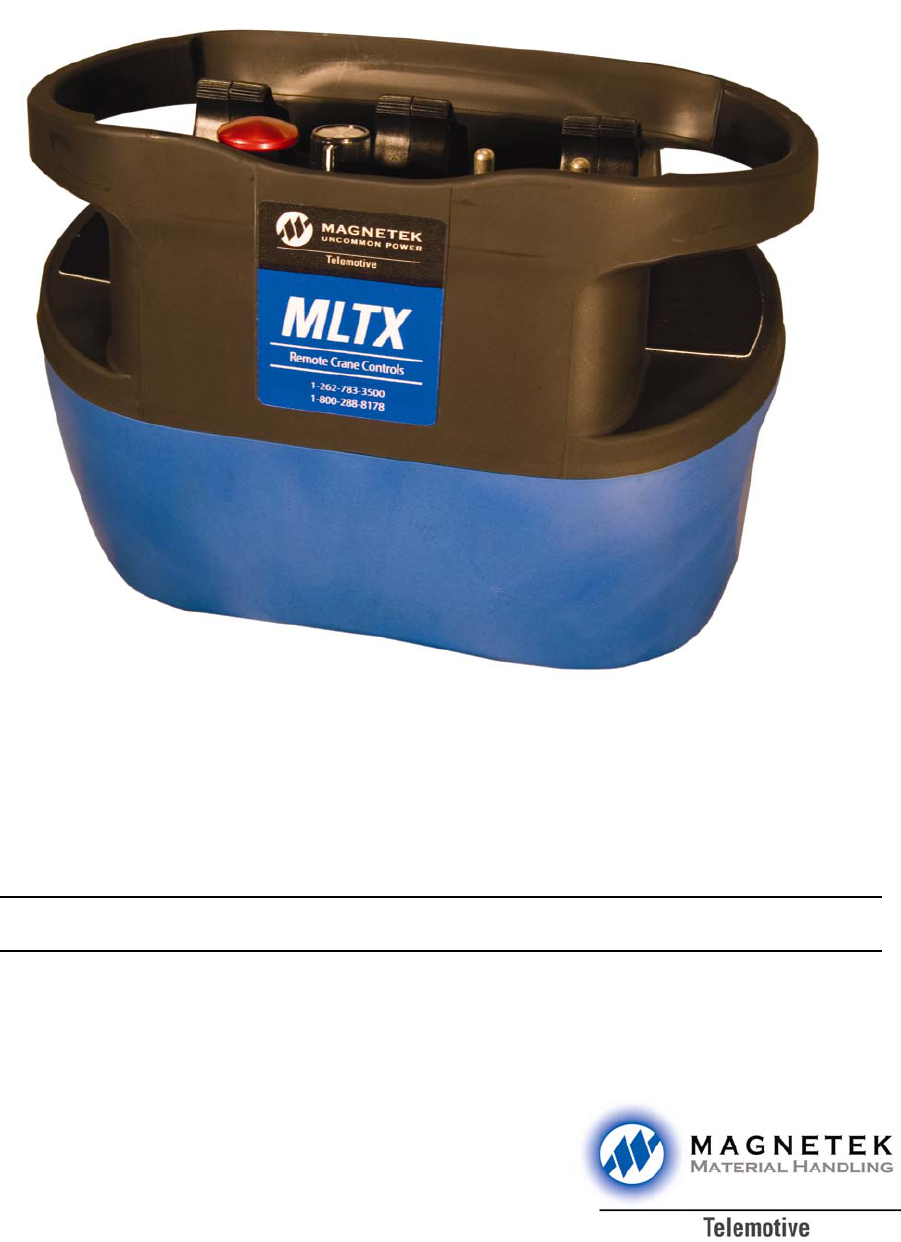
Magnetek Material Handling
Engineered MLTX Transmitter
Remote Crane Controls
Instruction Manual
TCENGMLTX-0 Rev. B March 2006
Part Number: 178-00840
©Copyright 2006 Magnetek Material Handling
©2006 MAGNETEK MATERIAL HANDLING
All rights reserved. This notice applies to all copyrighted materials included with this product,
including, but not limited to, this manual and software embodied within the product. This manual
is intended for the sole use of the persons to whom it is provided, and any unauthorized
distribution of the manual or dispersal of its contents is strictly forbidden. This manual may not
be reproduced in whole or in part by any means, whatsoever, without the expressed written
permission of MAGNETEK.

Telemotive MLTX Transmitter Instruction Manual—03/1/2006
1
Table of Contents
Your New Radio Remote & Service Phone Numbers p.2
1.1–1-13.3 Warnings, Cautions and Notes p.3-9
2-1. Power “ON-OFF” Switch p.10
2-2. E-STOP p.10
2-3. Motion Push Buttons, Joysticks or Levers p.10
2-4. Transmitter LED Indicator p.10
2-5. Time-Out Timer p.10
2-6. Key Switch (For Part 15 models not using active ESTOP, p.10
keyswitch disables power to transmitter circuitry only)
2-7. MLTX Transmitter Board Set-up Information p.11
2-8. Setting Access Code (For units with no external code plug only) p.11
2-9. Programming Switches p.12
2-10. To Check Out Data p.12
2-11. Battery Monitor p.12
2-12. Analog Voltage Reference p.12
2-13. Transmit LED p.12
2-14. Batteries p.12
2-15. Changing the Channel on the Part 15 Synthesized Transmitter p.12
2-16. Channel and Frequency Designating by Count p.13-14
2-17. Changing the Channel on the Part 90 VHF Synthesized Transmitter p.14
2-18. Replacement Parts p.15

Telemotive MLTX Transmitter Instruction Manual—03/1/2006
2
Your New Radio Remote
Thank you for your purchase of Magnetek’s Telemotive® brand MLTX Radio Remote Crane
Control. Magnetek has set a whole new standard in radio-remote performance, dependability, and
value with this unique new line of belly box transmitters. Without a doubt, our Telemotive
MLTX is the ultimate solution for having precise, undeterred, and safe control of your material.
If your product ever needs modification or service, please contact one of our representatives at the
following locations:
U.S. Service Information
For questions regarding service or technical information, contact 1-866-MAG-SERV
(1-866-624-7378).
Magnetek Material Handling
N49 W13650 Campbell Drive
Menomonee Falls, WI 53051
Telephone: 800-288-8178
Website: www.magnetekmh.com
e-mail: info@magnetekmh.com
Fax Numbers
Main: 800-298-3503
Sales: 262-783-3510
Service: 262-783-3508
For Canada Service Information Contact Berlet Electronics:
Phone: 1-905-564-2710
Fax: 1-905-564-2755
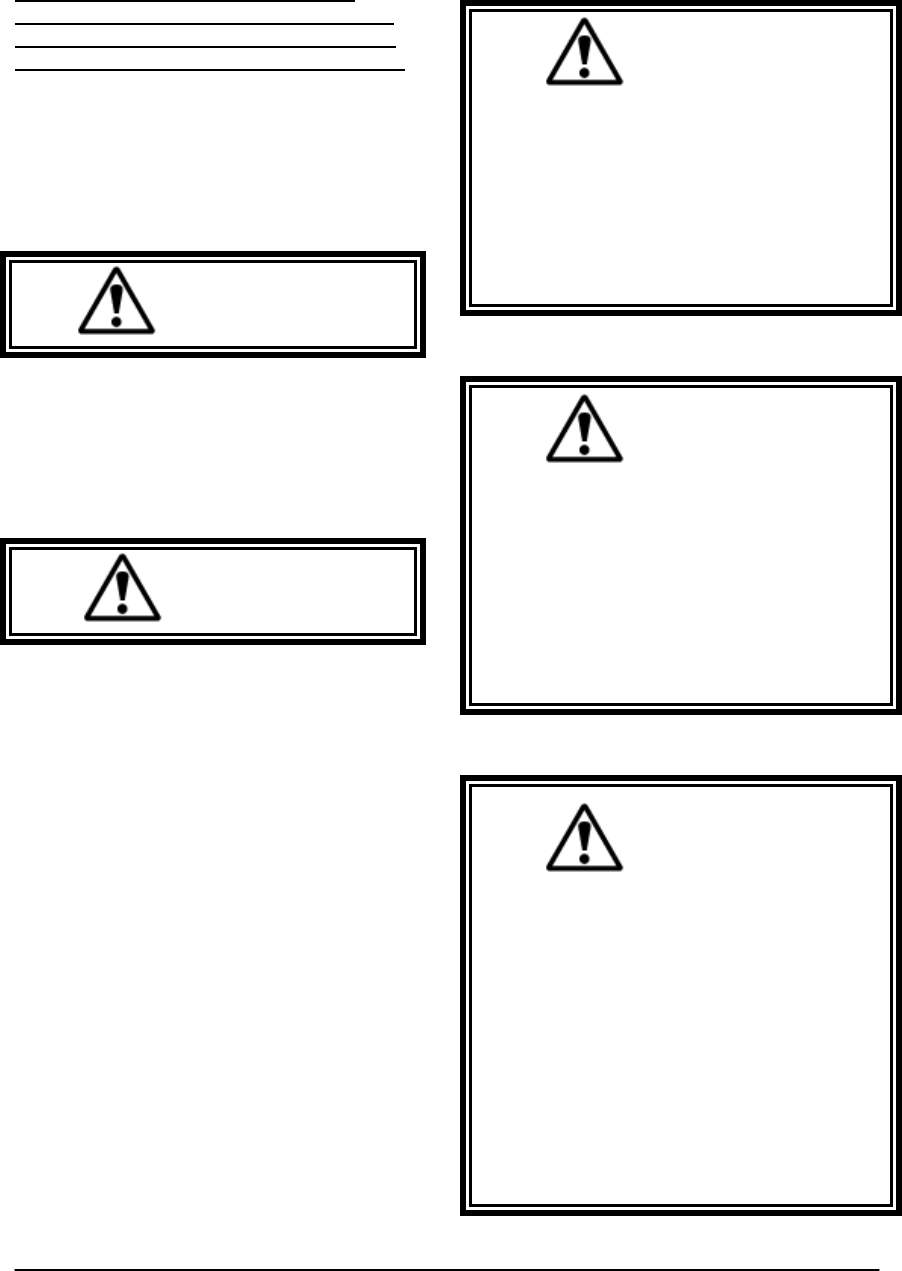
Telemotive MLTX Transmitter Instruction Manual—03/1/2006
3
1-1. Warnings, Cautions And Notes
Throughout this document WARNING,
CAUTION and NOTE statements have been
deliberately placed to highlight items critical
to the protection of personnel and equipment.
WARNING – A warning highlights an essential
operating or maintenance procedure, practice,
etc. which if not strictly observed, could result in
injury or death of personnel, or long term physi-
cal hazards. Warnings are highlighted as shown
below:
WARNING
CAUTION – A caution highlights an essential
operating or maintenance procedure, practice,
etc. which if not strictly observed, could result in
damage to, or destruction of equipment, or loss
of functional effectiveness. Cautions are high-
lighted as shown below:
CAUTION
NOTE – A note highlights an essential operating
or maintenance procedure, condition or state-
ment. Notes are shown as below:
NOTE
WARNINGS, CAUTIONS AND NOTES
SHOULD NEVER BE DISREGARDED.
The safety rules in this section are not intended
to replace any rules or regulations of any appli-
cable local, state, or federal governing organiza-
tions. Always follow your local lock out and tag
out procedure when maintaining any radio
equipment. The following information is
intended to be used in conjunction with other
rules or regulations already in existence. It is
important to read all of the safety information
contained in this section before installing or
operating the Radio Control System.
1-2. Critical Installation Considerations
WARNING
ALL EQUIPMENT MUST HAVE A
MAINLINE CONTACTOR INSTALLED AND
ALL TRACKED CRANES AND SIMILAR
EQUIPMENT MUST HAVE A BRAKE IN-
STALLED. FAILURE TO FOLLOW THIS
WARNING COULD RESULT IN SERIOUS
INJURY OR DEATH AND DAMAGE TO
EQUIPMENT.
WARNING
ON ALL REMOTE CONTROLLED CRANES
AN AUDIBLE AND/OR VISUAL WARNING
MEANS MUST BE PROVIDED. THESE AU-
DIBLE AND/OR VISUAL WARNING DE-
VICES MUST MEET ALL GOVERNMENTAL
REQUIREMENTS. FAILURE TO FOLLOW
THIS WARNING COULD RESULT IN SERI-
OUS INJURY OR DEATH AND DAMAGE TO
EQUIPMENT.
WARNING
PLEASE FOLLOW YOUR LOCAL LOCK
OUT TAG OUT PROCEDURE BEFORE
MAINTAINING ANY REMOTE CONTROL
EQUIPMENT. ALWAYS REMOVE ALL
ELECTRICAL POWER FROM THE CRANE
OR MACHINERY BEFORE ATTEMPTING
ANY INSTALLATION PROCEDURES. DE-
ENERGIZE AND TAG OUT ALL SOURCES
OF ELECTRICAL POWER BEFORE TOUCH
TESTING ANY EQUIPMENT. FAILURE TO
FOLLOW THIS WARNING COULD RESULT
IN SERIOUS INJURY OR DEATH AND
DAMAGE TO EQUIPMENT.

Telemotive MLTX Transmitter Instruction Manual—03/1/2006
4
WARNING
THE DIRECT OUTPUTS OF THIS PRODUCT
ARE NOT DESIGNED TO INTERFACE DI-
RECTLY TO TWO STATE SAFETY CRITI-
CAL MAINTAINED FUNCTIONS, I.E.,
MAGNETS, VACUUM LIFTS, PUMPS,
EMERGENCY EQUIPMENT, ETC. A ME-
CHANICALLY LOCKING INTERMEDIATE
RELAY SYSTEM WITH SEPARATE POWER
CONSIDERATIONS MUST BE PROVIDED.
FAILURE TO FOLLOW THIS WARNING
COULD RESULT IN SERIOUS INJURY OR
DEATH AND DAMAGE TO EQUIPMENT.
1-3. General
Radio controlled overhead cranes and other ma-
terial handling equipment operate in several di-
rections. They are large, bulky pieces of equip-
ment that efficiently handle heavy loads at high
speeds. Quite frequently, the equipment is oper-
ated in areas where people are working on the
floor below. The crane operator must exercise
extreme caution at all times. Workers must con-
stantly be alert to avoid accidents. The following
rules have been included to indicate how your
careful and thoughtful actions may prevent inju-
ries, damage to equipment, or even save a life. If
radio controlled material handling equipment is
operated from the cab, special care must be taken
to secure the transmitter. Refer to section titled
Section 1-9. Boarding The Crane for specific
safety rules.
1-4. Persons Authorized To Operate Radio
Controlled Cranes
Only properly trained persons designated by
management should be permitted to operate
radio controlled cranes.
Radio controlled cranes should not be operated
by any person who cannot read or understand
signs, notices and operating instructions that
pertain to the crane.
Radio controlled cranes should not be operated
by any person with insufficient eyesight or
hearing, or any person who may be suffering
from a disorder or illness, or is taking any medi-
cation that may cause loss of crane control.
1-5. Training Checklist For Crane Operators
Anyone being trained to operate a radio con-
trolled crane should possess, as a minimum, the
following knowledge and skills before operating
the crane:
1. The operator should have knowledge of
hazards pertaining to crane operation.
2. The operator should have knowledge of the
safety rules for radio controlled cranes.
3. The operator should have the ability to judge
distance of moving objects.
4. The operator should have knowledge of the
radio transmitter.
5. The operator should know how to properly
test limit switches.
6. The operator should know, where authorized,
instructions for plugging motions.
7. The operator should have knowledge of the
use of crane warning lights and alarms.
8. The operator should have knowledge of
observing crane signal lights.
9. The operator should be trained to avoid
striking any obstructions.
10. The operator should have knowledge of the
proper clearance of lifts or hooks before moving
bridge or trolley.
11. The operator should have knowledge of the
proper storage space for the radio control box
when not in use.
12. The operator should be trained in transferring
the radio control box to another person.
13. The operator should be trained how and
when to report unsafe or unusual operating
conditions.
14. The operator should be trained how to
exhibit caution in approaching bridge or trolley
bumpers.
15. The operator should know equipment
capacity.
16. The operator should be trained in making
lifts below floor level.

Telemotive MLTX Transmitter Instruction Manual—03/1/2006
5
17. The operator should be trained in making
side pulls.
18. The operator should know how to keep
himself and other people clear of lifts and to
avoid "pinch" points.
19. The operator should know cable and hook
inspection procedures.
20. The operator should know procedures for
testing hoist, trolley, and bridge brakes.
21. The operator should know and follow the
local Lock Out and Tag Out procedures.
1-6. Operating Area
Aisles between equipment, stock, etc., should be
free of obstructions so the crane operator can
move freely. These aisles should be a minimum
of three feet (one meter) wide, or meet local
regulations.
Crane operators should always position them-
selves for the best view of the crane they are
controlling. The crane should never be operated
blindly. The operator should stay as close to the
crane load as possible. Operators should never
position themselves in a “pinch” point.
1-7. Transmitter Unit
Transmitter switches should never be mechani-
cally blocked ON or OFF for any crane motion.
When not in use turn the transmitter OFF. A se-
cure storage space should be provided for the
transmitter unit and the transmitter unit should
always be placed there when not in use. This
precaution will prevent unauthorized people
from operating the crane.
Spare transmitters should be stored in a secure
storage space and only removed from the storage
space after the current transmitter in use has been
turned OFF, taken out of the service area and
secured.
1-8. Operating The Crane
1-8.1. Pre-operation Test
At the start of each work shift, or when a new
operator takes control of the crane, operators
shall do, as a minimum, the following steps
before making lifts with any crane or hoist:
Test the upper-limit switch. Slowly raise the
unloaded hook block until the limit switch trips.
When checking limit switches the hoist should
be centered over an area free of personnel and
equipment.
Visually inspect the hook, load lines, trolley, and
bridge as much as possible from the operator’s
station. In most instances this will be the floor of
the building.
The bridge and trolley brakes should be tested.
On transmitter units equipped with two or more
speeds use the “lowest” speed when testing
braking devices.
When lifting maximum loads the crane operator
should test the hoist brakes by raising the load a
few inches from the floor. If the brakes do not
hold, the load should immediately be lowered to
the floor.
If provided, test the lower-limit switch.
Test all warning devices.
Test all direction and speed controls for both
bridge and trolley travel.
Test all bridge and trolley limit switches, where
provided, if operation will bring the equipment
in close proximity to the limit switches.
Test the transmitter emergency stop.
Test the hoist brake to verify there is no drift
without a load.
If any crane or hoist fails any of the above tests
notify the supervisor and lock out and tag out for
repair.
1-8.2. General Rules For Operation
Consult the crane manufacturer and local and
governmental regulations for complete rules of
operation. In general the following rules apply to
remotely controlled cranes:
The limit switches should never be used as a
regular stopping device. They are intended to be
protective devices.
Do not make lifts in excess of the equipment
rated capacity.
The bridge and trolley should be centered di-
rectly over the load when the load is raised. This
will prevent swinging when making lifts.
A crane designed for this purpose and only with
supervisor permission should make side pulls.

Telemotive MLTX Transmitter Instruction Manual—03/1/2006
6
When a lift is being made, the crane operator
should not be positioned in the line of travel. The
crane or hoist should be operated from a position
either to the side or opposite from the direction
of travel.
When raising or lowering a load, proceed slowly
and make certain the load is under control. Tag
lines should be used for handling unusual lengths
or bulky loads. Remove slack from chains or
slings gradually. Make certain all personnel are
clear before making a lift.
The crane operator should keep all body parts
away from the lift and should never be posi-
tioned under the lift.
Do not make a lift or move a load if anyone is in
a location where they could be struck by the
crane or the load.
If the crane operator is being assisted, the crane
should not be moved until the assistant signals
they are clear of the crane and its load.
When a load is hanging from the crane hook and
the crane is being moved, the crane operator
should sound all warning devices frequently.
Loads should not be carried over workers heads.
If a worker is in the path of crane travel, the
crane operator should stop the crane and clear
the area before proceeding.
User/operator should never bump into runway
stops or other cranes.
When moving the crane, the crane operator
should be sure that the hook block and attach-
ments or cables will not catch on nearby
equipment. Slings, chains, or cables should never
be dragged along the floor.
Unless required for operator safety, gloves
should not be worn when operating the trans-
mitter unit.
All loose materials or parts should be removed
from the load before starting the lift.
The crane operator should always hoist lifts high
enough to clear all equipment and workers.
The crane operator should never permit anyone
to ride on the load or hook except when author-
ized by the supervisor.
When another crane on the same runway is sta-
tionary with a load hanging, the crane operator
should maintain a safe distance between the sta-
tionary crane and the one under their control.
Never leave suspended loads unattended. In an
emergency, if the crane is inoperative and a load
suspended, notify the supervisor immediately,
barricade and post signs on the floor beneath
crane and load.
If power to the crane is removed, the crane op-
erator should turn the transmitter unit OFF and
keep it OFF until power is restored.
If the crane fails to respond properly, the crane
operator should stop operation, turn the trans-
mitter unit OFF and immediately report the con-
dition to their supervisor.
Outdoor cranes, which are subject to movement
by wind, should be securely anchored when left
unattended. If the crane is equipped with bridge
brakes, the parking brake should be set immedi-
ately.
1-9. Boarding The Crane
The crane should not be boarded without permis-
sion of the supervisor.
The crane operator should turn off the transmitter
and take it with them when boarding the crane.
If more than one person is boarding the crane,
one person should be made responsible for en-
suring all personnel are off the crane before the
system is returned to operation.
1-10. Crane Maintenance And Repair
Qualified personnel must maintain a regularly
scheduled crane inspection (i.e., such as
monthly). During this crane inspection the
functionality and safety of the crane remote
control must also be tested. The inspection shall
include, but not be limited to items listed in
Section 1-12. Condition of The Radio Controlled
Crane. Consult the crane manufacturer and local
and governmental regulations for recommended
inspection intervals and proper inspection
procedures. Problems noted during this
inspection must be repaired before using the
crane or the remote control.
Minor repairs include routine maintenance, such
as greasing, cleaning and control
troubleshooting. All other repairs should be con-
sidered major. If the repair crew consists of

Telemotive MLTX Transmitter Instruction Manual—03/1/2006
7
several people, one person should be designated
as the repair crew leader. (see responsibilities
below). If the repair crew consists of only one
person, that person has the following
responsibilities:
For minor repairs, warning signs should be
placed on the floor beneath the crane or sus-
pended from the crane. For major repairs, the
floor area below the crane should be roped off.
When major repairs are to take place, all persons
operating other cranes on the same or adjacent
runways, must be notified prior to starting
repairs. Notification should include the nature of
the repair, safeguards provided, and movement
limitations while repairs are in progress.
When practical, radio controlled cranes which
cannot be moved during repairs, must be pro-
tected against being bumped into by other cranes
on the runway. Cranes under repair should have
bumpers installed on the exposed side or sides of
the crane. They should be placed as far away as
possible. Indicate the location of the bumpers by
placing red lights clearly visible to other crane
operators traveling on the same runway. When it
is not possible to use bumpers, place red lights in
a location that is clearly visible to other crane
operators traveling on the same runway. This
will indicate that there is a restricted travel zone.
All crane operators on the same runway must be
informed of the repair effort and thoroughly
instructed to what their operations are limited to
and informed they will be notified when repairs
are completed.
If any hazard involving the repairmen exists
when there is a runway adjacent to the crane un-
der repair, the adjacent runway should be
blocked off as described above. When it is nec-
essary to continue crane operation on the adja-
cent runways, warning lights must be installed
and visible to the operators of cranes on those
runways. All cranes should come to a complete
stop prior to entering the restricted area and
should proceed through this area only after re-
ceiving permission from a signal person desig-
nated for this purpose. Access of persons to and
from the crane being repaired should be under
control of the repair crew leader.
When boarding the crane, the transmitter should
be turned OFF and the transmitter should remain
with the repair crew leader. The leader should
board the crane first, open and lock out the main
switch, and then signal the other members of the
crew it is safe to board the crane.
If work on the crane is to be done in areas not
protected by standard handrails, the repair crew
should wear approved safety belts.
All tools and equipment should be moved onto
the crane by the use of hand lines. The tools and
equipment should be adequately secured to the
hand lines.
If it is necessary to have the crane control cir-
cuits energized, all power circuits for crane
movement must be opened prior to energizing
the control circuits.
During repairs and before moving the crane all
personnel and tools should be moved to a safe
spot.
Headroom is at a minimum in some crane cabs
and on some crane walkways. Exercise caution
when boarding or working on cranes. Wear hard
hats whenever possible.
When repairs are finished, all personnel, tools
and repair equipment should be removed before
energizing the crane circuits.
1-11. Using The Crane As A Work Platform
When the crane is to be used as a stationary work
platform, follow all rules provided in Section 1-
10. Crane Maintenance and Repair. When it is
necessary for the crane to be moved from time to
time, the crane operator should board the crane
with the transmitter unit. The crane operator
should ensure all personnel working on the crane
are in a secure position before moving the crane
to the next workstation. It should also be the
crane operator’s responsibility to ensure the main
switch is open and locked down before work is
resumed.
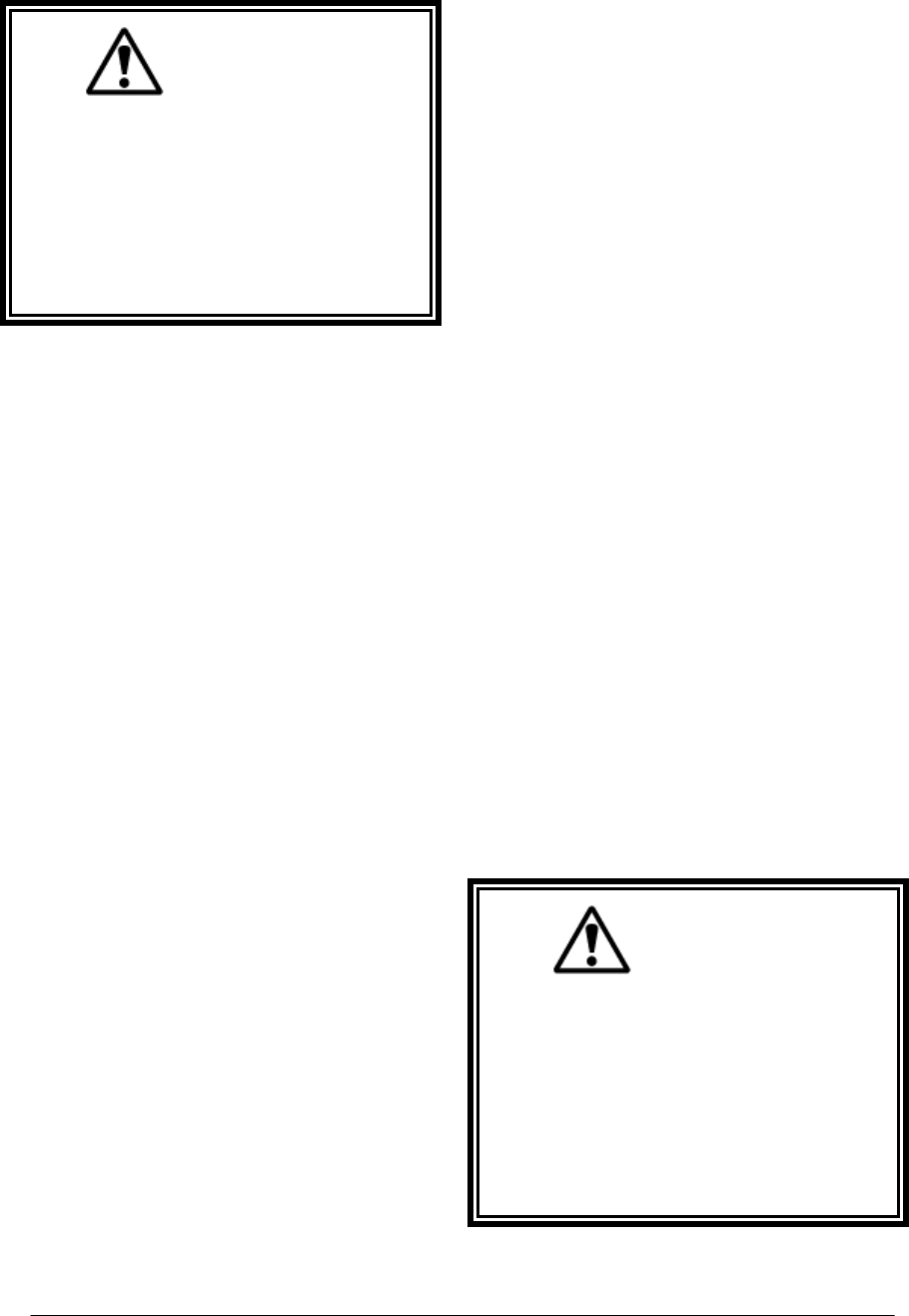
Telemotive MLTX Transmitter Instruction Manual—03/1/2006
8
WARNING
THE CRANE OPERATOR SHOULD NOT AT-
TEMPT TO REPAIR ANY OF THE ITEMS
STATED BELOW. THE CRANE CONDITION
SHOULD BE REPORTED TO THE SUPERVI-
SOR. FAILURE TO FOLLOW THIS WARN-
ING COULD RESULT IN SERIOUS INJURY
OR DEATH AND DAMAGE TO EQUIP-
MENT.
1-12. Condition Of The Radio Controlled
Crane
If the crane fails to respond properly, the crane
operator(s) should notify their supervisor. When
serious conditions are noticed (conditions that
make the crane unsafe to operate), the crane
operator should shut down the crane immediately
and the supervisor should be notified. The
following is a list of some of the items that
should be included in the report (See the crane
manufacturer for specifics and possible
additional items):
Condition of hoisting cable and hook block (bro-
ken strands, clipped sheave wheels, etc.).
Condition of brakes (hoist, trolley, and bridge).
(No bluing, rivets on shoes showing, glazing,
etc.).
Condition of trolley and rail stops.
Condition of bridge structure.
Condition of festoon system.
Broken welds in any part of the crane structure.
Proper fluid levels and lubrication.
Condition of bridge and trolley stops.
Carbon dust or signs of burning on the covers of
motors.
Indication of fluid, oil or grease leaks.
Condition of rail sweeps.
Walkways require handrails and ladders are
sturdy, in place and not loose.
Protective guards are in place for all moving
parts.
Alignment of bridge (screeching or squealing
wheels indicate bridge is out of line).
Broken, cracked, or chipped rails on trolley or
runway.
Condition of limit switches.
Condition of electrical and mechanical control
(electrical or mechanical defects which cause
faulty operation such as uncommanded stopping
or starting of any crane motions, warning de-
vices, lights, or auxiliary functions).
Condition of gears (grinding or squealing may
indicate foreign materials in gear teeth or a lack
of lubrication.
All controls, especially E-STOPs, are in place
and in working order.
Frequent relay tripping of power circuits.
Mechanical parts loosened by vibration (loose
rivets, covers, bolts, etc.).
Uneven riding (worn or damaged wheels).
Condition of collector shoes or bars.
Condition of warning or signal lights and horns.
(Burned out or broken).
1-13. Batteries
WARNING
KNOW AND FOLLOW PROPER BATTERY
HANDLING, CHARGING AND DISPOSAL
PROCEDURES. IMPROPER BATTERY PRO-
CEDURES CAN CAUSE BATTERIES TO
EXPLODE OR DO OTHER SERIOUS DAM-
AGE. FAILURE TO FOLLOW THIS WARN-
ING COULD RESULT IN SERIOUS INJURY
OR DEATH AND DAMAGE TO EQUIP-
MENT.

Telemotive MLTX Transmitter Instruction Manual—03/1/2006
9
1-13.1. Battery Handling
Use only batteries approved by Telemotive for
the specific product.
Do not dispose of a battery pack in fire. It may
explode.
Do not attempt to open the battery pack.
Do not short circuit battery.
For intrinsically safe environments only use
specified Telemotive intrinsically safe batteries.
Keep the battery pack environment cool during
charging operation and storage, (i.e., not in direct
sunlight or close to a heating source).
1-13.2. Battery Charging
For those transmitters equipped with battery
chargers, please familiarize all users with the
instructions of the charger before attempting to
use.
Use only Telemotive approved chargers for the
appropriate battery pack.
Do not attempt to charge non-rechargeable bat-
tery packs.
Avoid charging the battery pack for more than
24 hours at a time.
Do not charge batteries in a hazardous environ-
ment.
Do not short charger.
Do not attempt to charge a damaged battery.
Do not attempt to use a battery that is leaking,
swollen or corroded.
Charger units are not intended for outdoor use.
Use only indoors.
1-13.3. Battery Disposal
Before disposing of batteries consult local and
governmental regulatory requirements for proper
disposal procedure.

Telemotive MLTX Transmitter Instruction Manual—03/1/2006
10
CAUTION
Before operating the transmitter, familiarize yourself with all safety information in this manual
and any other local, state, or federal rules or regulations already in existence.
2-1. Power “ON-OFF” Switch (Turns transmitter and receiver ON and OFF)
With the key switch (optional) engaged, pressing the ON/OFF push-button switch (Part 15) starts
the transmitter, pushing it again starts the receiver. Or toggling the ON/OFF toggle switch (Part
90) turns the transmitter and the receiver ON. If the transmitter is ON the BATT MONITOR light
is ON or flashing. Pushing the ON/OFF button again (Part 15), or resetting the toggle switch to
OFF (Part 90), will turn the transmitter and receiver OFF.
2-2. E-STOP (For Emergency Stopping only)
When depressed, the MCR relay is opened, the receiver shuts down, and power to the equipment
is immediately stopped. Under normal operating conditions, the E-STOP must be raised. The
transmitter must be turned OFF and ON again to restore normal operation. Use the E-STOP for
emergency stopping only, not for normal system shut down. The E-STOP will not function with
the optional key switch turned OFF.
2-3. Motion Push Buttons, Levers
To activate motor functions, press and hold the push-button or lever that corresponds to the
desired motion. The extent to which the push-button or lever is pushed, dictates the speed of the
motor function.
2-4. Transmitter LED Indicator
The transmitter LED (red) indicates the transmitter is on, or transmitting, or has a low battery
voltage. A slow flash rate indicates the unit is ON. A rapid flash rate indicates the unit is
transmitting (when a function or control is activated). If the battery goes below a safe level, the
LED will not light. Replace battery soon.
2-5. Time-Out-Timer
Unless this function is disabled, the transmitter will turn itself OFF if not used for 15 minutes.
2-6. Key Switch. (For Part 15 Models not using active E-STOP, disables power to
transmitter circuitry only)
For models so equipped, turning the key OFF and removing it will disable the transmitter. If the
key switch is turned OFF with the transmitter and receiver on, the key switch must be turned ON
again to use the ON/OFF push button or E-STOP. Turning the key switch to ON enables power to
the transmitter unit, but does not activate the transmitter controls or turn ON the receiver. The
ON/OFF push button must be pushed to turn the transmitter and receiver ON or OFF. Under
normal procedures it is recommended that the unit be turned OFF with the ON/OFF push button
before turning OFF the key switch.
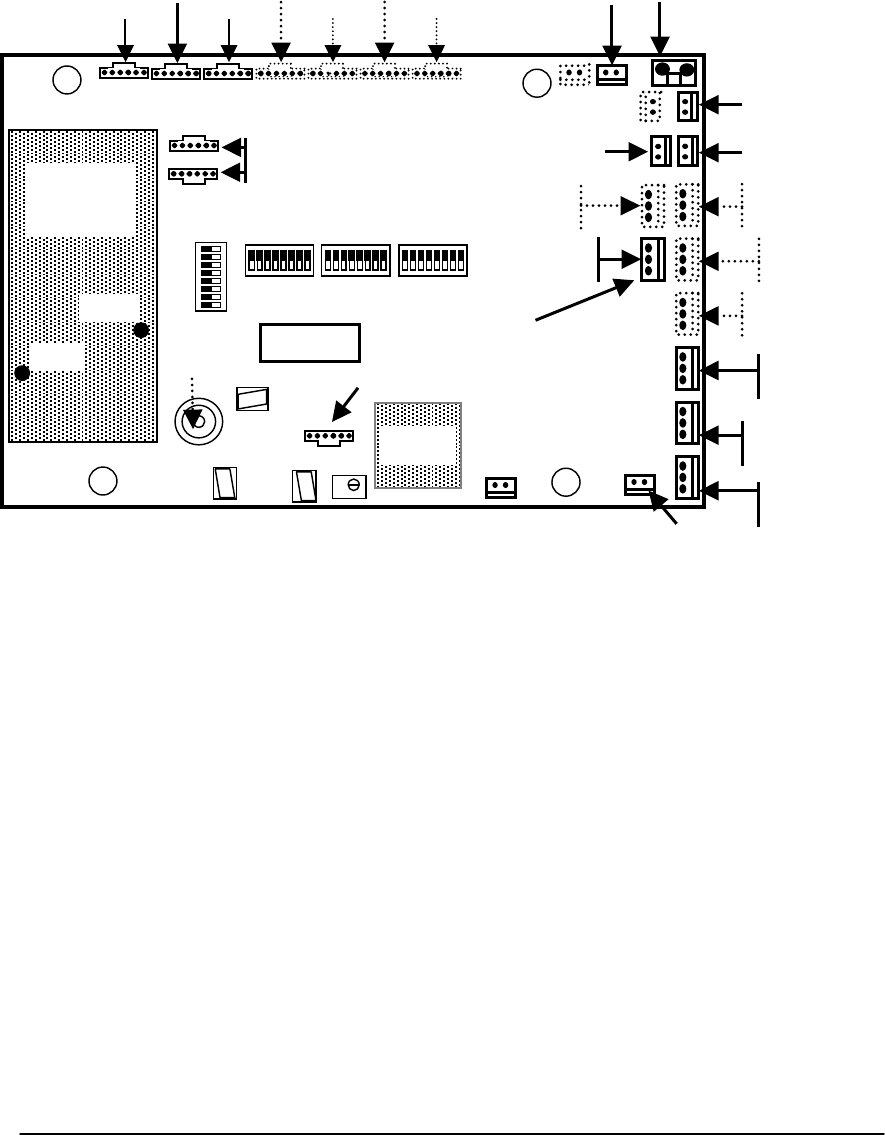
Telemotive MLTX Transmitter Instruction Manual—03/1/2006
11
2-7. MLTX Transmitter Board Setup Information.
The MLTX Transmitter Board is shown in Figure 2-7. Refer to paragraphs 1-2 through 1-10 for
servicing procedures.
2-8. Setting Access Code (for units with no external code plug only)
The access code is set at the factory and should not be changed unless absolutely necessary. If a
spare transmitter unit is used, the receiver unit access code should be changed to match the access
code of the spare transmitter unit. For Part 15 systems the access codes are printed on a white
label on the outside of any transmitter and may be matched to “A” and “B” on the receiver CPU
Board without having to open the transmitter housing.
Switch SW2 (B) in the transmitter must match switch S4 (B) on the receiver CPU Board and
switch SW1 (A) in the transmitter must match switch S5 (A) on the CPU Board.
For Part 90 systems the 12 bit access code is assigned starting with position A1 through A8 then
B1 through B4. For 8 bit access codes, switch B is not used. See system documentation for the
Part 90 access code.
If the codes do not match, you will get an error light DS9 on the CPU Board while transmitting.
TP2
GND
TP1
TP3 RPOT2
OFF
8---------1
SW1 “A”
OFF
8---------1
SW2 “B”
OFF
8---------1
SW3 “C”
SW4 “D”
8---------1
OFF
Tilt Switch
(Optional) E10607
J10 LOW BATT.
J25
J19
J18
J14
J13
J12
J11
J15
J35
J17
J1 BATT.
MONITOR
E
EP
PR
RO
OM
M
D
D
A
A
T
T
A
A
R
R
F
F
S
S
W
W
J2 J3 J4 J5 J6 J7 J8
J16
J26
TP4 +5V
J28
J27
To Multiple Code
P
lu
g
Board E10611
J27 to J1, J28 to J2
Motor Motor Motor J24 J20
Motor 2 Motor 4 Motor 6 Motor Key Switch Battery Input
1 3 5 7
J22
J9 Firmware Loading Connector
Firmware
Number Label
Figure 2-7. MLTX Transmitter Board

Telemotive MLTX Transmitter Instruction Manual—03/1/2006
12
2-9. Programming Switches
The programming switches in SW3 (C) controls the following features: (These only apply to units
originally programmed to utilize these features).
External Code Plug Enable – Switch SW3 (C) – position 1 turn “ON” to enable external code
plug.
Processor to send Software ID to PC Enable – Switch SW3 (C) – position 6 turn “ON” to allow
special software to be enabled to read the software ID. (Only Magnetek authorized personnel has
the ability to view.)
Tilt Switch Enable – Switch SW3 (C) – position 7 turn “ON” to enable the Tilt Switch.
Time-Out-Timer Disable – Switch SW3 (C) – position 8 turn “ON” to disable the transmitter
time-out timer.
2-10. To Check Data.
1). For data input use the Data pin on the RF Module.
2). Use the RF SW pin on the RF Module for an External Trigger input.
3). Use test point TP2, for Ground.
2-11. Battery Monitor
Set to 5.8 Volts by R6 and R8 (not adjustable.)
2-12. Analog Voltage Reference
V+ (TP3) factory is adjusted with RPOT2. V- (TP1) factory is adjusted with RPOT2.
2-13. Transmit LED
This flashing red LED flashes rapidly during transmit, slowly when unit is ON and turns out
when battery is low.
2-14. Batteries
Two batteries are available, a disposable alkaline battery (9V, BT113-0), a rechargeable NiMH
(7.2V, BT114-0), and a rechargeable NiMH (12V, BT115-0). The charger for the BT114-0 and
BT115-0 is E10757-0. You can attach up to two E10757-1 (piggyback chargers) to the E10757-0
charger. The typical recharge time for a completely discharged battery is approximately three
hours. While NiMH batteries give improved performance over NiCAD, any rechargeable battery
will give its best performance if the battery is fully discharged before recharging. Please follow
local regulations for the disposal of any battery product.
2-15. Changing the Channel on the Part 15 Synthesized Transmitter
The channel can be changed by removing the logic board from the bottom housing. Locate the
rotary switches on the RF Transmitter Board (see Figure 2-15 MLTX Synthesizer Board). The
rotary switch nearest the corner of the board is the “ones” place-value selection (0-9). The rotary
switch near the middle of the board is the “tens” place-value selection (10, 20, and 30).
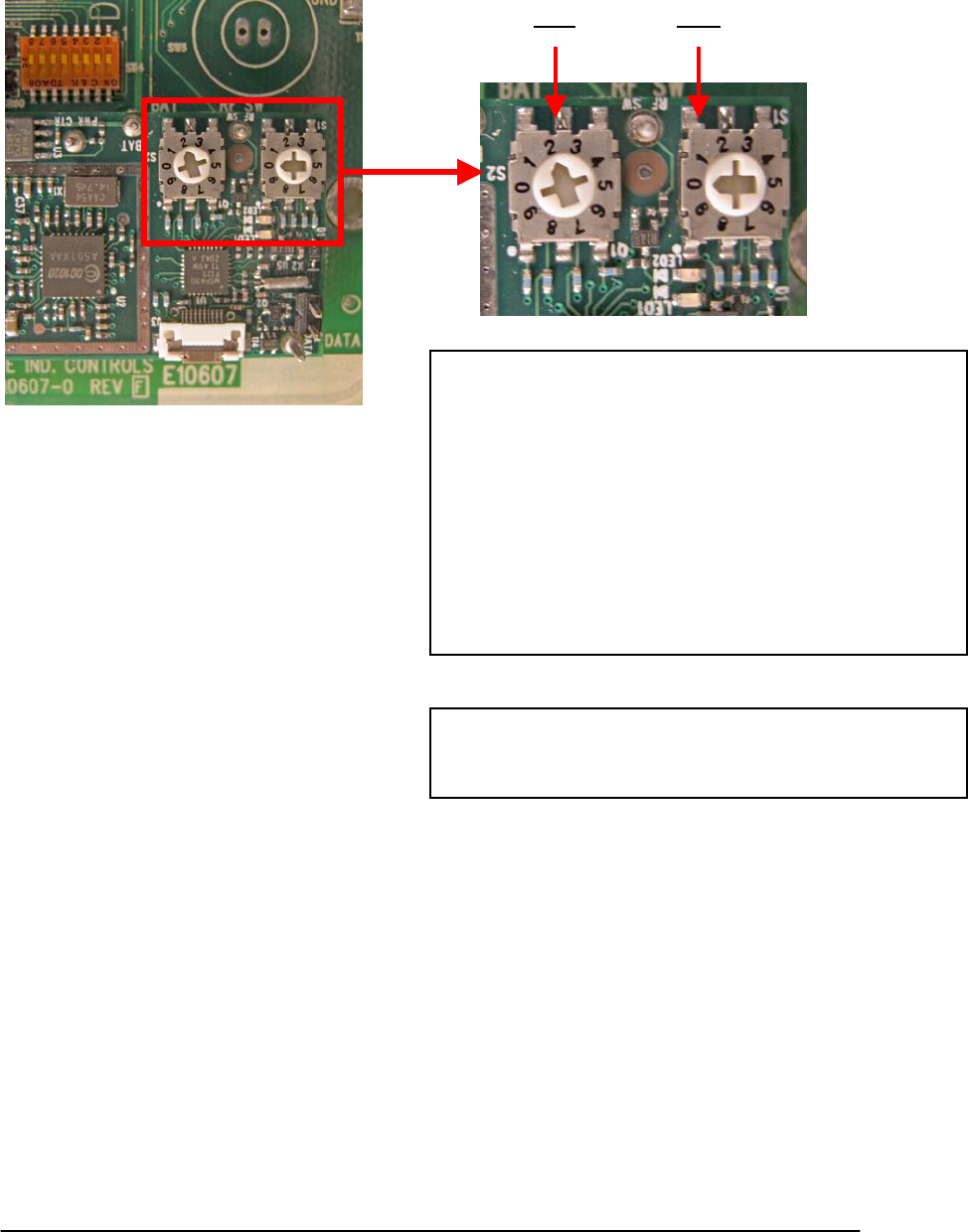
Telemotive MLTX Transmitter Instruction Manual—03/1/2006
13
Figure 2-15 MLTX Synthesizer Board
Indicator Channel Actual
Count Designator Frequency
01. AK01 439.8 MHz
02. AK02 439.6 MHz
03. AK03 439.4 MHz
04. AK04 439.2 MHz
05. AK05 439.0 MHz
06. AK06 438.8 MHz
07. AK07 438.6 MHz
08. AK08 438.4 MHz
09. AK09 438.2 MHz
10. AK10 438.0 MHz
11. AK11 437.8 MHz
12. AK12 437.6 MHz
13. AK13 437.4 MHz
14. AK14 437.2 MHz
15. AK15 437.0 MHz
16. AK16 436.8 MHz
17. AK17 436.6 MHz
18. AK18 436.4 MHz
19. AK19 436.2 MHz
20. AK20 436.0 MHz
21. AKA00 433.125 MHz
22. AKA01 433.325 MHz
23. AKA02 433.525 MHz
24. AKA03 433.725 MHz
25. AKA04 433.925 MHz
26. AKA05 434.125 MHz
AK 20 would be
Tens Ones
2 0
Compliance Statement (Part 15.19)
This device complies with Part 15 of the FCC Rules. Operation
is subject to the following two conditions:
1. This device may not cause harmful interference, and
2. This device must accept any interference received,
including interference that may cause undesired
operation.
Warning (Part 15.21)
Changes or modification not expressly approved by the party
responsible for compliance could void the user’s authority to
operate the equipment.
2-16. Channel and Frequency
Designations by Count
This portable transmitter with its antenna complies with FCC’s
RF exposure limits for general population/uncontrolled
exposure.
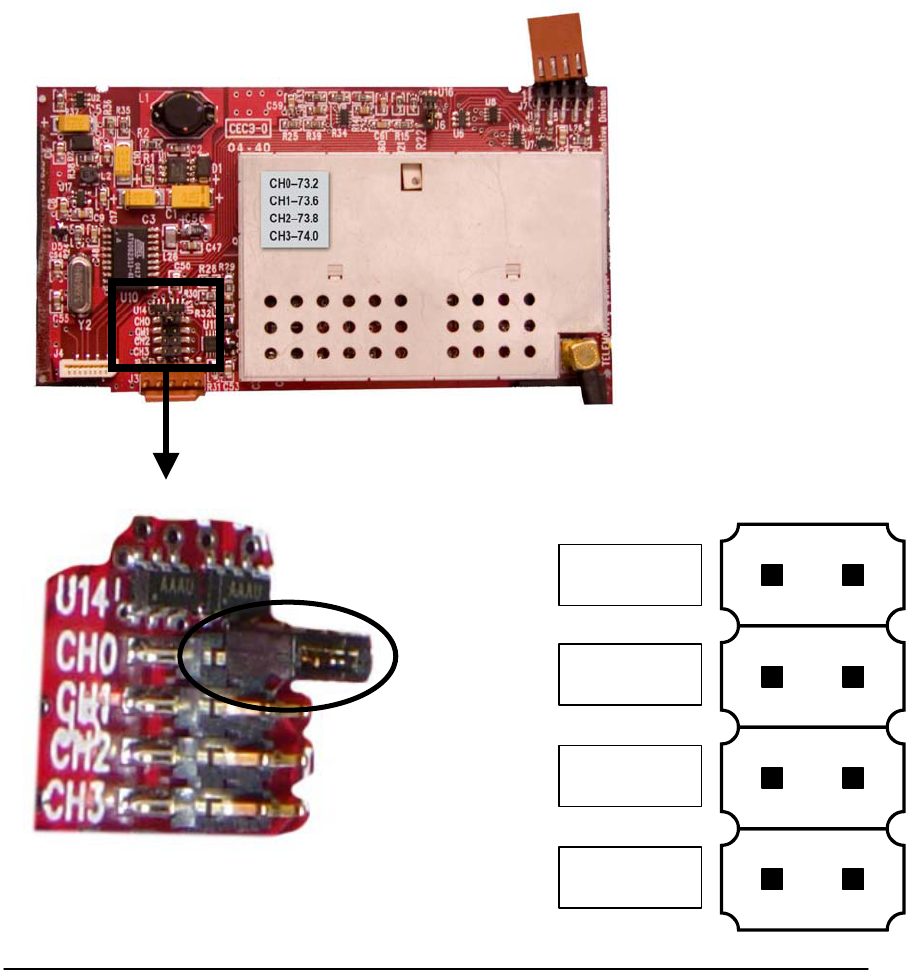
Telemotive MLTX Transmitter Instruction Manual—03/1/2006
14
27. AKA06 434.325 MHz
28. AKA07 434.525 MHz
29. AKA08 434.725 MHz
30. AK38 432.4 MHz
31. AK50 430.0 MHz
2-17. Changing the channel on the Part 90 VHF Synthesized Transmitter
The Part 90 VHF transmitter can be programmed for up to four different channels. The pre-
programmed channels can be changed by moving the jumper to another channel. Please refer to
the label on the transmitter board for the frequency of each channel.
Indicator Channel Actual
Count Designator Frequency
Channel
Jumper C H 1
C H 0
C H 2
C H 3
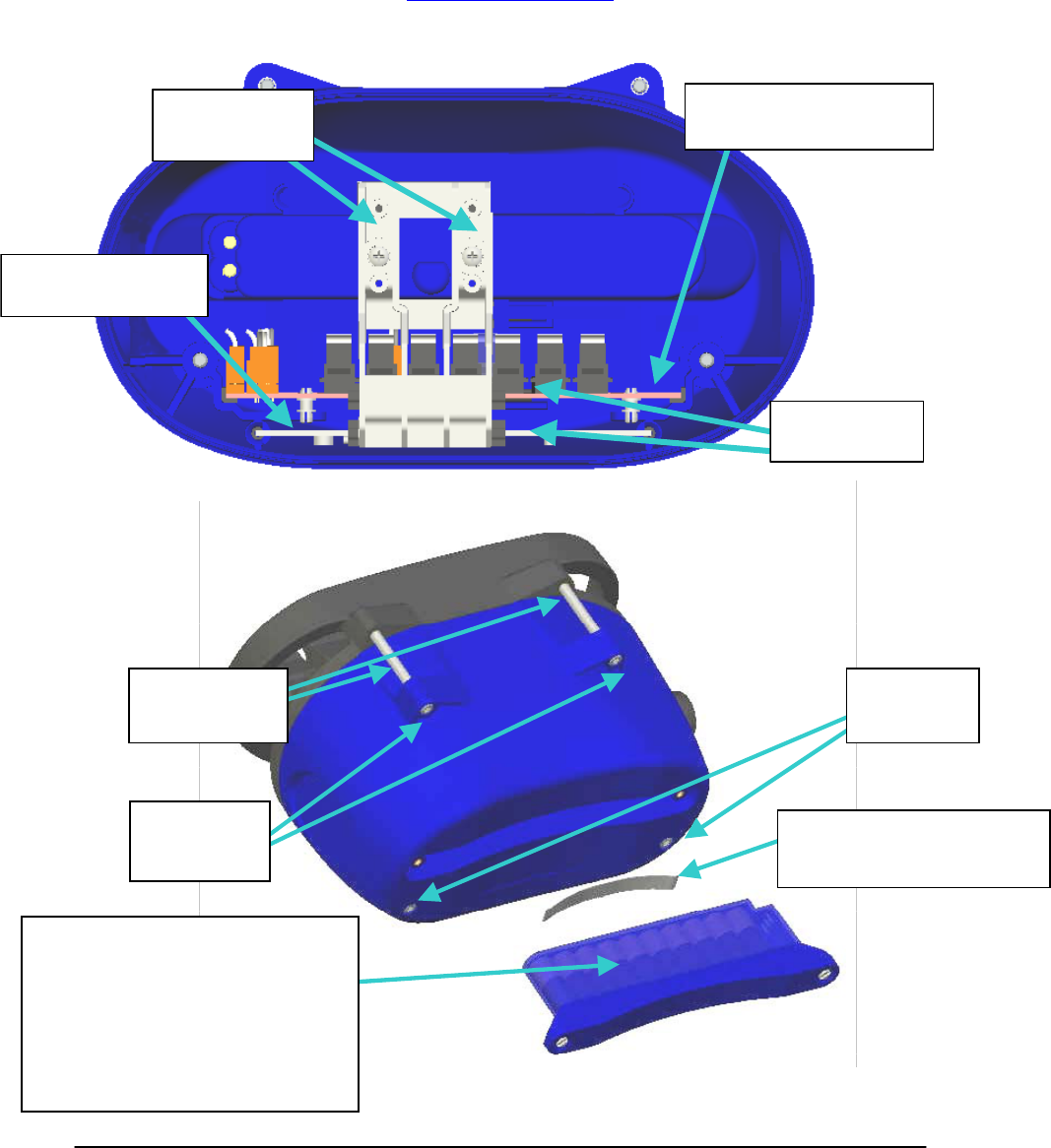
Telemotive MLTX Transmitter Instruction Manual—03/1/2006
15
2-18. Replacement Parts
If your transmitter ever needs repair, we always recommend that you contact Magnetek for
service. If you need to refer to a parts list please refer to your transmitter’s drawing that was
included in the shipment of your transmitter. If you have trouble locating the drawing, the latest
version is available on our web site at www.magnetekmh.com. For replacement batteries,
chargers and hardware, please see the following drawings.
2 Screws
H1252-0
Part 15 Antenna
Synthesized CPU
Board
2 Foam Pads
Synthesized CPU
Boar
d
2 Belt Tubes
H1161-0
2 Screws
H1159-0
Battery
BT113-0 Alkaline (disposable)
BT114-0 NiMH (re-chargeable)
E10757-0 Charger for BT114-0
E10757-1 Piggyback Charger
(up to 2 per E10757-0)
2 Screws
H1158-0
Battery Ejector Spring
MP10755-0